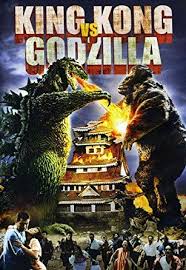
“I’m sick of Godzilla. Send a wire. Immediately! I want my own monster. Find me a monster, fast!”
Mr. Tako (Ichiro Arishima) is the head of Pacific Pharmaceuticals. His company sponsors television shows on a local network. He is not happy with the ratings his shows are getting. He needs something special to give them a boost. He has heard of a giant monster discovered on a small island in the Pacific called Pharaoh Island. He likes the idea of a giant monster. It will be good publicity. He sends two of his employees Osamu Sakurai (Tadao Takashima) and Kinsaburo Furue (Yu Fujiki) check it out. Their orders are to find and bring back the monster.
Meanwhile, in the Arctic, the American submarine “Seahawk” is damaged when it is hit by a collapsing iceberg. Inside the iceberg is Godzilla. Godzilla is released. He blows up the submarine and destroys a military base. Then he heads for Japan.
Sakurai and Furue are on Pharaoh Island looking for the monster. The villagers feed it a juice made from a local berry. A gigantic octopus crawls ashore and attacks the village. King Kong appears and beats up the octopus. Kong then drinks the berry juice and falls asleep. While he is passed out, Sakurai and Furue package him up and take him to Japan.
Godzilla reaches Japan and begins wreaking havoc. Kong wakes up and breaks free from the raft he was tied to. Kong and Godzilla come face to face. Kong tosses some big rocks at Godzilla. Godzilla responds by torching Kong’s hair with his fire breath. Kong retreats. At least for the time being.
After some attempts by the military to handle both Godzilla and King Kong, they finally come to the realization that Japan may be better off if the two behemoths battle each other instead of both ganging up on Japan. Perhaps then maybe they will kill each other.
“King Kong vs Godzilla” was released in 1962 in Japan and 1963 in the US. The movie was directed by Ishiro Honda and was produced and distributed by Toho Studios. It is the third film in the Godzilla franchise, and the first of two Toho produced films featuring King Kong. It is also the first time that both characters are in color.
The director of special effects was Eiji Tsuburaya. There were four live octopuses used in the fight sequence with Kong, as well as a plastic model. Hot air was blown on them to get them to move. After the filming of the scene was finished, the octopuses were then released except for one, which Tsuburaya had for dinner. The octopus special effects were actually quite good. Hopefully for Mr. Tsuburaya, they were also tasty.
There isn’t a whole lot different between the Japanese and the American version of the story. The American version does do some cutting and adds some additional commentary but the main plot is basically the same. It’s not the best King Kong I’ve ever seen but looking at the movie through Honda’s eyes makes it entertaining.
Honda intended for the film to be a satire on the television industry. He stated "People were making a big deal out of ratings, but my own view of TV shows was that they did not take the viewer seriously, that they took the audience for granted....so I decided to show that through my movie. The reason I showed the monster battle through the prism of a ratings war was to depict the reality of the times. All a medicine company would have to do is just produce good medicines you know? But the company doesn't think that way. They think they will get ahead of their competitors if they use a monster to promote their product."
English dubbed

